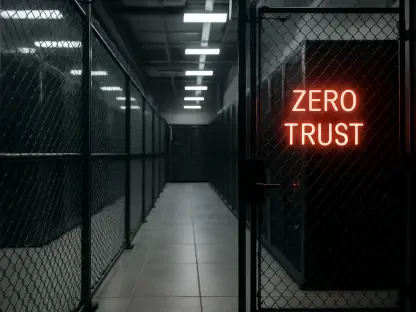The landscape of cybersecurity has undergone significant transformation with the advent of Zero Trust Solutions, a paradigm shift that hinges on the principle of “never trust, always verify.” As organizations increasingly embrace cloud computing, remote work, and hybrid environments, Zero Trust Solutions have emerged as an essential tool in safeguarding sensitive data and ensuring secure access.
The Shift to Zero Trust
Zero Trust marks a fundamental departure from traditional perimeter-based security models, which relied on a secure network perimeter to protect internal resources. Recognizing that threats can originate both inside and outside an organization’s network, Zero Trust adopts a more stringent approach. It enforces strict access controls, continuous verification of users and devices, and granular segmentation to mitigate risks of unauthorized access and lateral movement within a network.
This approach is designed to ensure that no entity is inherently trusted, and every access request is thoroughly authenticated and authorized based on context-specific data such as user identity, device health, and location. By focusing on verifying identities and maintaining granular control over access permissions, Zero Trust Solutions provide a robust defense against evolving cyber threats.
Core Principles of Zero Trust Solutions
The primary objective of Zero Trust Solutions is to guarantee that every access request, whether from users, devices, or applications, is authenticated, authorized, and encrypted in real-time. This is achieved through the integration of several key components, including Identity and Access Management (IAM), Multi-Factor Authentication (MFA), Zero Trust Network Access (ZTNA), and micro-segmentation.
IAM solutions play a vital role in managing user identities and access permissions, ensuring that only authorized individuals can access sensitive resources. MFA enhances security by requiring multiple forms of verification, reducing the risk of credential-based attacks. ZTNA offers secure, granular access to applications and data, regardless of the user’s location. Micro-segmentation minimizes the attack surface by isolating different parts of the network, preventing unauthorized lateral movement.
These components work in tandem to create a robust security framework that adapts to dynamic environments and emerging threats. By continuously verifying users and devices, Zero Trust Solutions provide a comprehensive and proactive approach to cybersecurity.
Benefits of Zero Trust Solutions
Implementing Zero Trust Solutions brings numerous benefits to organizations, making them a crucial aspect of modern cybersecurity strategies. Enhanced security is perhaps the most notable advantage, as these solutions eliminate implicit trust by continuously verifying users and devices. This reduces the attack surface and prevents lateral movement within networks, effectively containing potential breaches.
Improved threat detection and response are also key benefits. Real-time monitoring detects unusual behavior or unauthorized access attempts, allowing for prompt, automated responses that mitigate risks before significant damage occurs. Zero Trust Solutions adapt seamlessly to modern work environments, supporting secure remote work and enforcing consistent security policies across on-premises, cloud, and hybrid setups.
Better user experiences are another significant benefit, as Zero Trust Solutions simplify authentication processes and minimize latency compared to legacy VPN solutions. Additionally, these solutions facilitate regulatory compliance by enforcing strict access controls and maintaining audit trails, ensuring adherence to standards like GDPR, HIPAA, and PCI DSS.
Perimeter 81
Perimeter 81 stands out in the realm of Zero Trust Solutions, offering a comprehensive Secure Access Service Edge (SASE) platform that integrates Zero Trust Network Access (ZTNA), Firewall as a Service (FWaaS), and Secure Web Gateway (SWG) into a unified solution. This platform simplifies secure access to corporate networks, cloud resources, and applications, making it a preferred choice for organizations seeking robust security measures.
Perimeter 81’s features include application-specific access controls, compliance enforcement, and an intuitive dashboard for streamlined management. These capabilities collectively ensure that resources are accessed only by authenticated and authorized users, reducing the risk of unauthorized access. However, during high traffic volumes, performance issues may arise, impacting user experience. Additionally, advanced features are often locked behind higher-tier pricing plans, which may pose a challenge for smaller organizations with limited budgets.
Twingate
Twingate offers a cloud-based Zero Trust Network Access (ZTNA) platform that replaces traditional Virtual Private Networks (VPNs). By enforcing least-privilege access policies, Twingate ensures secure access without necessitating changes to network configurations or IP addresses. This platform’s rapid deployment capabilities and integration with tools like Okta make it a valuable asset for organizations seeking a seamless transition to Zero Trust principles.
Key features of Twingate include the implementation of least-privilege access and the elimination of public exposure for network resources. These measures significantly enhance security, ensuring that users have access only to the resources they need. However, more advanced features may require technical expertise for optimal deployment and management. Additionally, lower-tier plans may lack certain enterprise-grade features, which could limit functionality for larger organizations with complex security needs.
NordLayer
NordLayer is designed to implement Zero Trust Network Access (ZTNA) and Secure Access Service Edge (SASE) principles, offering advanced security features like network segmentation and Multi-Factor Authentication (MFA). This platform allows secure access to on-site resources through a virtual Local Area Network (LAN), facilitating connectivity without compromising security.
NordLayer integrates seamlessly with tools such as Okta, enabling centralized management and streamlined authentication processes. Despite its advantages, some features are restricted to higher-tier pricing plans, potentially limiting access for smaller organizations. Additionally, the platform does not support IPv6 and may offer limited functionality in regions such as China, which could be a consideration for global organizations.
ThreatLocker
ThreatLocker is a robust Zero Trust Endpoint Protection Platform that employs proactive measures like application allowlisting and storage control to block unauthorized access and malicious activities. This platform provides comprehensive protection against malware, ransomware, and zero-day attacks, ensuring that endpoints remain secure.
ThreatLocker also complies with regulatory standards through detailed logs and audit trails, aiding in adherence to security protocols. However, advanced configuration may necessitate technical expertise, which could be a hurdle for organizations with limited IT resources. Furthermore, higher-tier features may be cost-prohibitive for smaller businesses, requiring careful consideration of budget constraints.
UTunnel
UTunnel offers flexible deployment options, including cloud-hosted and self-hosted Virtual Private Network (VPN) servers, making it suitable for businesses of varying sizes. By enhancing security with continuous authentication of users and devices, and providing centralized control of users, devices, and permissions, UTunnel ensures a secure environment for accessing sensitive resources.
On the downside, self-hosting requires technical expertise, which may pose a challenge for organizations without dedicated IT personnel. Additionally, some advanced features are restricted to higher-tier plans, potentially limiting functionality for smaller businesses. It is essential for organizations to assess their specific requirements and resources when considering UTunnel’s offerings.
Palo Alto Networks Prisma Access
Palo Alto Networks Prisma Access is a comprehensive Secure Access Service Edge (SASE) platform that combines advanced networking and security capabilities into a unified solution. This platform ensures secure connectivity for users, branch offices, and data centers worldwide, making it a preferred choice for global enterprises.
Prisma Access offers granular role-based access control, data loss prevention, and protection against web-based threats, enhancing overall security. However, the advanced features may require expertise for optimal configuration and management. Additionally, higher-tier pricing plans may be expensive for smaller organizations, necessitating a careful evaluation of budget constraints.
Zscaler Private Access (ZPA)
Zscaler Private Access (ZPA) is a Zero Trust Network Access (ZTNA) platform that connects users directly to authorized private applications without exposing them to the network or the internet. This approach reduces security risks and provides scalable, clientless access for unmanaged devices and legacy systems, making it suitable for diverse IT environments.
While ZPA enhances security and offers seamless integration with cloud providers, policy configurations can be complex for new users, requiring technical expertise. Moreover, performance may be affected by reliance on the public internet, which could impact user experience during periods of high traffic. These considerations are vital for organizations evaluating ZPA’s suitability for their specific needs.
Illumio Core
Illumio Core leverages micro-segmentation to prevent the spread of breaches across cloud and on-premises workloads, offering comprehensive insights into application dependencies and traffic flows. This platform enables actionable security decisions and rapid response capabilities to stop ransomware spread, making it a valuable tool for threat mitigation.
While Illumio Core’s advantages are clear, complex configurations may require expertise for large-scale implementation. Higher-tier pricing can be costly, necessitating a thorough evaluation of budget constraints and organizational requirements. Despite these challenges, Illumio Core’s detailed reporting aids in compliance, facilitating adherence to security standards.
Absolute ZTNA
Absolute ZTNA employs a software-defined perimeter to enforce Zero Trust principles, providing uninterrupted protection by automatically repairing tampered clients and adapting access rules based on device posture. This platform improves productivity and security, ensuring that access policies remain robust and dynamic.
Advanced configurations may require technical expertise, presenting a potential challenge for organizations with limited IT resources. Higher-tier features could result in higher costs, necessitating careful assessment of budget constraints. Absolute ZTNA’s ability to adapt to changing security needs makes it a valuable asset for organizations seeking resilient cybersecurity measures.
Appgate SDP
The landscape of cybersecurity has evolved dramatically with the introduction of Zero Trust Solutions, a paradigm shift based on the principle of “never trust, always verify.” This approach represents a significant shift from traditional security models, which often assumed that threats could be contained by a secure perimeter.
As more organizations adopt cloud computing, remote work, and hybrid environments, the necessity for Zero Trust Solutions has become increasingly evident. By continuously verifying every user and device attempting to access network resources, these solutions help protect sensitive data and ensure secure access. This is crucial in an era where cyber threats are becoming more sophisticated and frequent, rendering older security methods obsolete.
Zero Trust Solutions work on the idea that threats can originate both outside and inside the network, thereby requiring stringent controls and real-time monitoring. Implementations often include multi-factor authentication, micro-segmentation, real-time analytics, and least-privilege access principles.
In summary, Zero Trust Solutions have emerged as an essential component for modern cybersecurity strategies. They offer robust protection by requiring verification at every stage, thus maintaining the security of sensitive data. In today’s world, where technological advancements and work culture shifts continually alter the cybersecurity landscape, Zero Trust provides a forward-thinking solution to new and evolving threats.









